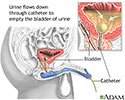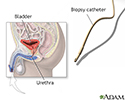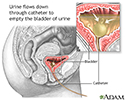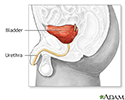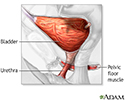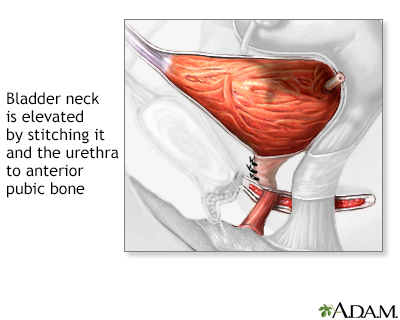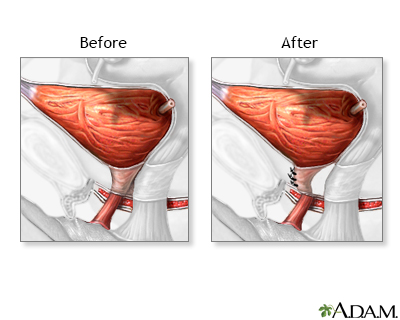Bladder cancer
Transitional cell carcinoma of the bladder; Urothelial cancerBladder cancer is a cancer that starts in the bladder. The bladder is the body part that holds and releases urine. It is in the center of the lower abdomen.
Bladder function - neurological control - Animation
Bladder function - neurological control
Animation
Bladder catheterization - male
Catheterization is accomplished by inserting a catheter (a hollow tube, often with and inflatable balloon tip) into the urinary bladder. This procedure is performed for urinary obstruction, following surgical procedures to the urethra, in unconscious patients (due to surgical anesthesia, coma, or other reasons), or for any other problem in which the bladder needs to be kept empty (decompressed) and urinary flow assured. The balloon holds the catheter in place for a duration of time. Catheterization in males is slightly more difficult and uncomfortable than in females because of the longer urethra.
Bladder catheterization - male
illustration
Bladder biopsy
A bladder biopsy is performed if abnormalities of the bladder are found, or if a tumor is grossly visible. During the biopsy a small portion of tissue is removed and sent to the laboratory for analysis.
Bladder biopsy
illustration
Bladder catheterization - female
A catheter (a hollow tube, often with an inflatable balloon tip) may be inserted into the urinary bladder when there is a urinary obstruction, following surgical procedures to the urethra, in unconscious patients (due to surgical anesthesia, coma, or other reasons), or for any other problem in which the bladder needs to be kept empty (decompressed) and urinary flow assured. The balloon holds the catheter in place for a duration of time.
Bladder catheterization - female
illustration
Male bladder anatomy
Urine travels from the bladder through the urethra to be excreted from the body.
Male bladder anatomy
illustration
Bladder and urethral repair - series
Presentation
Bladder and urethral repair - series
Presentation
Bladder function - neurological control - Animation
Bladder function - neurological control
Animation
Bladder catheterization - male
Catheterization is accomplished by inserting a catheter (a hollow tube, often with and inflatable balloon tip) into the urinary bladder. This procedure is performed for urinary obstruction, following surgical procedures to the urethra, in unconscious patients (due to surgical anesthesia, coma, or other reasons), or for any other problem in which the bladder needs to be kept empty (decompressed) and urinary flow assured. The balloon holds the catheter in place for a duration of time. Catheterization in males is slightly more difficult and uncomfortable than in females because of the longer urethra.
Bladder catheterization - male
illustration
Bladder biopsy
A bladder biopsy is performed if abnormalities of the bladder are found, or if a tumor is grossly visible. During the biopsy a small portion of tissue is removed and sent to the laboratory for analysis.
Bladder biopsy
illustration
Bladder catheterization - female
A catheter (a hollow tube, often with an inflatable balloon tip) may be inserted into the urinary bladder when there is a urinary obstruction, following surgical procedures to the urethra, in unconscious patients (due to surgical anesthesia, coma, or other reasons), or for any other problem in which the bladder needs to be kept empty (decompressed) and urinary flow assured. The balloon holds the catheter in place for a duration of time.
Bladder catheterization - female
illustration
Male bladder anatomy
Urine travels from the bladder through the urethra to be excreted from the body.
Male bladder anatomy
illustration
Bladder and urethral repair - series
Presentation
Bladder and urethral repair - series
Presentation
Bladder cancer
Transitional cell carcinoma of the bladder; Urothelial cancerBladder cancer is a cancer that starts in the bladder. The bladder is the body part that holds and releases urine. It is in the center of the lower abdomen.
Bladder cancer
Transitional cell carcinoma of the bladder; Urothelial cancerBladder cancer is a cancer that starts in the bladder. The bladder is the body part that holds and releases urine. It is in the center of the lower abdomen.
Review Date: 3/31/2024
Reviewed By: Todd Gersten, MD, Hematology/Oncology, Florida Cancer Specialists & Research Institute, Wellington, FL. Review provided by VeriMed Healthcare Network. Also reviewed by David C. Dugdale, MD, Medical Director, Brenda Conaway, Editorial Director, and the A.D.A.M. Editorial team.


